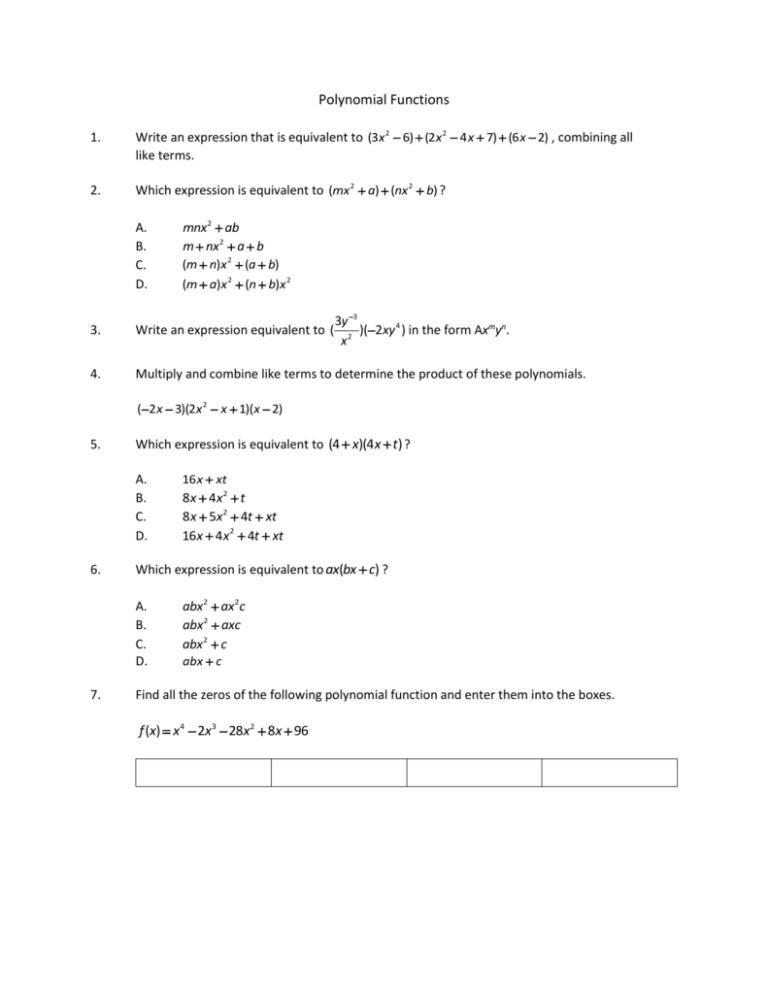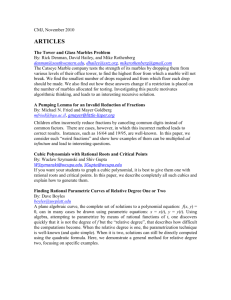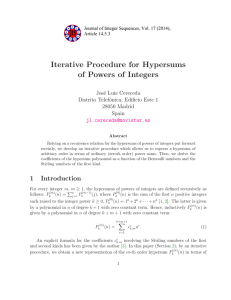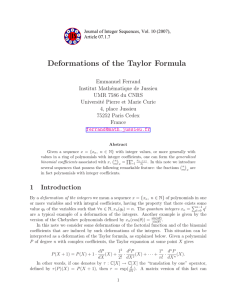Polynomial Functions
advertisement

Polynomial Functions 1. Write an expression that is equivalent to (3x 2 6) (2 x 2 4 x 7) (6 x 2) , combining all like terms. 2. Which expression is equivalent to (mx 2 a) (nx 2 b) ? A. B. C. D. mnx2 ab m nx 2 a b (m n)x 2 (a b) (m a)x 2 (n b)x 2 3y 3 )(2xy 4 ) in the form Axmyn. x2 3. Write an expression equivalent to ( 4. Multiply and combine like terms to determine the product of these polynomials. (2 x 3)(2 x 2 x 1)(x 2) 5. Which expression is equivalent to (4 x)(4 x t) ? A. B. C. D. 6. 8x 4 x2 t 8 x 5x2 4t xt 16 x 4 x2 4t xt Which expression is equivalent to ax(bx c) ? A. B. C. D. 7. 16x xt abx 2 ax 2c abx 2 axc abx 2 c abx c Find all the zeros of the following polynomial function and enter them into the boxes. f (x) x 4 2x 3 28x2 8x 96 8. Kiera claims that the sum of two linear polynomials with rational coefficients is always a linear polynomial with rational coefficients. Use the numbers 1 (first) through 6 (last) to place the statements into a logical sequence to outline an argument that proves Kiera’s claim. Statement Order (1 is first, 6 is last) p(x) q(x) (ax cx) (b d) p(x) q(x) (ax b) (cx d) Given p(x) ax b and q(x) cx d where a, b, c, and d are rational numbers. (a c) and (b d) are rational numbers So p(x) q(x) is a linear polynomial with rational coefficients. p(x) q(x) (a c)x (b d) 9. P(x) is a 4th degree polynomial. The graph of y P(x) has exactly three distinct x-intercepts. Part A Which polynomial could be P(x)? A. B. C. D. x 3 (x 3) x 2 (x 2)(x 1) (x 3)(x 2)(x 1) x(x 3)(x 2)(x 1) Part B For one of the polynomials above, explain why it could not be P(x). 10. Proposition 1 The sum of two linear polynomials with integer coefficients is always a linear polynomial with integer coefficients. The outline of a proof of Proposition 1 is shown. Add one or more justifications for steps 3, 4, and 5 of the proof from the list of justifications below. The Closure of the Integers Under Addition The sum of two integers is always an integer The Commutative Property If A and B are real numbers, then A + B = B + A The Associative Property If A, B, and C are real numbers, then (A + B) + C = A + (B + C) The Distributive Property If A, B, and C are real numbers, then A(B + C) = AB + AC The Any-Order Property of Addition The sum of two or more real numbers can be performed in any order or any grouping. Statement Given p(x) ax b and q(x) cx d where a, b, c, and d are integers. Justification p(x) q(x) (ax b) (cx d) By Definition Hypothesis p(x) q(x) (ax cx) (b d) p(x) q(x) (a c)x (b d) (a c) and (b d) are integers So p(x) q(x) is a linear polynomial with integer coefficients. Conclusion Teacher Material A-SSE.A Interpret the structure of expressions. A-APR.A Perform arithmetic operations on polynomials. F-IF.A Understand the concept of a function and use function notation. F-IF.C Analyze functions using different representations. F-BF.A Build a function that models a relationship between two quantities. Question Claim 1 2 3 4 1 1 1 1 5 6 7 1 1 2 8 3 Key/Suggested Rubric 1 point: 5x 2 2x 1 , or equivalent expression with 3 terms. 1 point: Selects C. 1 point: Writes –6x–1y. 1 point: Writes 4 x 4 4 x 3 9 x 2 5x 6 , or equivalent expression with 5 terms. 1 point: Selects D. 1 point: Selects B. 1 point: x = –4, x = 6, x = –2, and x = 2 (in any order). NOTE: Allow students to just write the values of x (–4, 6, –2, and 2) in the boxes. 1 point: Statement Order (1 is first, 6 is last) p(x) q(x) (ax cx) (b d) 3 p(x) q(x) (ax b) (cx d) 2 Given p(x) ax b and q(x) cx d where a, b, c, and d are rational numbers. (a c) and (b d) are rational numbers So p(x) q(x) is a linear polynomial with rational coefficients. p(x) q(x) (a c)x (b d) 9 3 1 5 6 4 2 points: Selects B AND Explains why A, C, or D could not be P(x). Example 1: A could not be P(x) because its graph only has two distinct x-intercepts at 0 10 3 and 3. Example 2: C could not be P(x) because it’s only a 3rd degree polynomial. Example 3: D could not be P(x) because its graph has 4 distinct xintercepts at 0, 3, 2, and 1. 1 point: Selects B OR Explains why A, C, or D could not be P(x). 1 point: Statement Justification Given p(x) ax b and q(x) cx d where a, b, c, and Hypothesis d are integers. p(x) q(x) (ax b) (cx d) By Definition p(x) q(x) (ax cx) (b d) The Any-Order Property of Addition OR The Commutative Property p(x) q(x) (a c)x (b d) The Distributive Property (a c) and (b d) are integers The Closure of the Integers Under Addition So p(x) q(x) is a linear polynomial with integer coefficients. Conclusion








